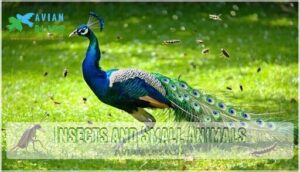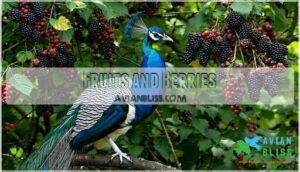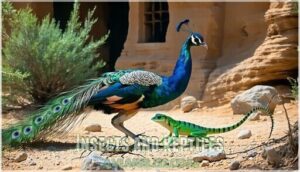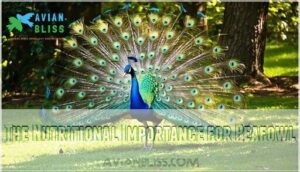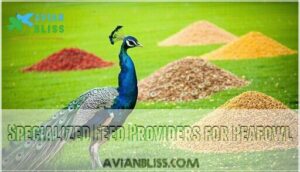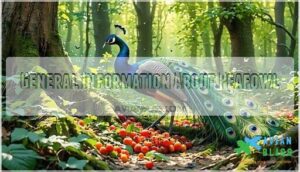This site is supported by our readers. We may earn a commission, at no cost to you, if you purchase through links.
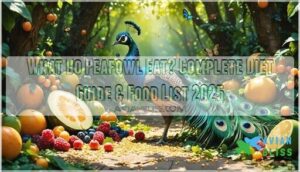
These stunning birds munch on fruits, seeds, grains, insects, small reptiles, and even flower petals.
You’ll find they’re true omnivores, adapting their meals based on what’s available in their environment.
In the wild, they forage for berries, beetles, and grass seeds, while captive peafowl thrive on specialized game bird feed mixed with fresh produce.
Their diet changes with the seasons too – they need extra protein during breeding season and more carbs in winter.
Understanding what peafowl eat reveals fascinating insights about their feeding behaviors and nutritional needs.
Table Of Contents
- Key Takeaways
- Peafowl Dietary Overview
- What Do Peafowl Eat?
- What Do Peafowl Eat in The Wild?
- What Do Peafowl Eat in Captivity?
- Seasonal Dietary Changes for Peafowl
- The Nutritional Importance for Peafowl
- Specialized Feed Providers for Peafowl
- Other Dietary Details for Peafowl
- General Information About Peafowl
- Frequently Asked Questions (FAQs)
- What does a peafowl eat?
- What to do if a peacock shows up in your yard?
- What is the natural enemy of a peacock?
- What can peafowl not eat?
- How much water do peafowl need daily?
- Can peafowl eat kitchen scraps safely?
- What foods are toxic to peafowl?
- How often should peafowl be fed?
- Do baby peafowl have different dietary needs?
- Conclusion
Key Takeaways
- You’ll need to provide a diverse omnivorous diet – peafowl eat fruits, seeds, grains, insects, small reptiles, and flower petals, requiring both plant matter and protein sources for optimal health and vibrant plumage.
- Your feeding approach should change with the seasons – increase protein to 20-28% during breeding season for egg production and fertility, while providing more carbohydrates and energy-dense foods during winter months.
- You can’t rely on basic poultry feed alone – captive peafowl need specialized game bird feed as their foundation, supplemented with fresh produce, mealworms, and avoiding toxic foods like chocolate, avocados, and bread.
- You’ll benefit from their natural pest control abilities – peafowl actively hunt insects, ticks, small snakes, and garden pests, making them valuable for property management while meeting their protein requirements.
Peafowl Dietary Overview
What makes peafowl such fascinating eaters? These magnificent birds follow an omnivore diet that changes with the seasons and their environment.
You’ll find that peafowl have diverse nutritional needs, requiring both plant matter and protein sources to maintain their stunning plumage. Their foraging habits involve spending most daylight hours searching for food on the ground.
In the wild, they adapt their peafowl diet based on what’s available, while captive feeding requires careful planning to meet their peafowl nutrition requirements. Understanding what peafowl eat helps you provide proper peafowl food whether they’re roaming free or living in managed settings.
Stainless steel dishes offer durability and hygiene. Seasonal variations play a vital role in their feeding patterns throughout the year.
What Do Peafowl Eat?
You’ll find that peafowl have surprisingly diverse appetites, eating everything from seeds and berries to insects and small reptiles.
Their omnivorous diet changes throughout the year, with different foods providing the nutrients they need for their famous colorful plumage and overall health.
Plant-Based Diet
Peafowl embrace nature’s salad bar with enthusiasm, making plant matter their dietary foundation.
Their beaks work like garden tools, plucking tender shoots and colorful blooms from their surroundings. You’ll find these birds savoring a diverse peafowl plant diet that fuels their spectacular displays.
Looking at the paragraph about peafowl’s plant-based diet, here’s a short blockquote in the same engaging tone:
Nature’s gardeners expertly harvest their colorful feast with precision and grace.
Here’s what fills their vegetarian menu:
- Leafy Greens – Fresh spinach, lettuce, and wild grasses provide essential vitamins
- Flower Petals – Rose petals and marigold blooms add natural pigments for vibrant plumage
- Seeds Benefits – Sunflower and millet seeds deliver healthy fats and protein
- Grain Variety – Wheat, corn, and oats supply steady energy for daily activities
- Foraging Plants – Wild berries, tender shoots, and edible roots round out their natural peafowl diet.
Seeds are vital, providing essential proteins and fats for birds.
Insects and Small Animals
When you observe peafowl hunting, you’ll notice their impressive insect foraging skills in action.
These birds excel at prey capture, targeting insects, arthropods, and small reptiles with remarkable precision.
Their peafowl insect diet includes everything from crickets to spiders, providing essential protein for digestion efficiency.
Adult peafowl can even handle venomous prey like scorpions.
The chick diet relies heavily on soft insects during early development.
This varied peafowl diet guarantees they receive necessary nutrients for feather development and overall health, ensuring their digestion efficiency.
What Do Peafowl Eat in The Wild?
In the wild, you’ll find peafowl foraging as opportunistic omnivores that adapt their diet based on what’s available in their natural habitat.
These ground-dwelling birds spend most of their day searching for a diverse mix of plant matter and animal protein across forests, grasslands, and cultivated areas.
Fruits and Berries
Wild peafowl frequently feast on nature’s candy throughout their habitat.
Nature’s sweetest treats fuel these magnificent birds’ vibrant displays and seasonal energy needs.
You’ll discover these birds enthusiastically consuming blackberries, elderberries, mulberries, and wild grapes when seasonal availability peaks.
Their strong beaks easily pierce tough fruit skins, accessing valuable berry nutrition that supports vibrant plumage development.
Fruit variety in their peafowl natural diet includes figs, rose hips, and hawthorn berries.
However, you must avoid toxic fruits like cherry pits and apple seeds in captive supplementation.
This peafowl food preference shifts seasonally, with fall bringing abundant berries that become essential peafowl diet components, providing antioxidants and natural sugars for energy, which is crucial for their overall health and energy.
Grains and Seeds
Beyond fruits and berries, you’ll discover grains and seeds scattered across your territory.
These nutrient-rich morsels provide essential carbohydrates and proteins for your daily energy needs.
- Seed Variety: Wild seeds from grasses, weeds, and flowering plants offer diverse nutrition throughout seasons
- Grain Digestion: Your strong beak cracks tough seed coats, while your digestive system processes fibrous materials efficiently
- Sprouted Grains: Fresh germinated seeds contain higher protein levels, making them ideal peafowl food during breeding periods
Insects and Reptiles
You’ll discover that nature’s protein buffet extends beyond seeds and grains when watching these magnificent birds hunt.
Peafowl actively pursue insects and small reptiles with remarkable precision, using their sharp eyesight and quick reflexes for insect hunting. Their foraging techniques include scratching through leaf litter and stalking prey across open ground.
Remarkably, peafowl possess some venom resistance, allowing safe consumption of small snakes and scorpions. Chick diets heavily depend on this protein source for proper development.
| Insects | Small Reptiles |
|---|---|
| Crickets | Small snakes |
| Ticks | Lizards |
| Scorpions | Geckos |
| Beetles | Baby iguanas |
| Locusts | Salamanders |
This peafowl insect diet provides essential amino acids for feather development and reproductive success, making reptile consumption equally important for their nutritional balance. Like many bird species, peafowl have seasonal diet changes, adapting their food choices based on availability.
What Do Peafowl Eat in Captivity?
When you keep peafowl in captivity, their diet needs careful planning to replace what they’d naturally find in the wild.
You’ll need to provide commercial gamebird feed as their base nutrition, supplemented with fresh fruits, vegetables, and protein sources to maintain their health and stunning plumage.
Supplemented Feeds
In captivity, your peafowl thrive on commercial poultry feed and game bird feed as their foundation.
These balanced diet supplements provide essential nutrition, but you’ll want to add variety with kitchen scraps and treats.
- Cat kibble – High-protein boost for vibrant plumage
- Hard-boiled eggs – Natural protein source with mineral additives
- Cooked rice and grains – Energy-rich carbohydrates for daily activities
- Unsalted nuts – Healthy fats supporting electrolyte balance
Commercial feeds often include vitamin supplements and probiotic benefits for peak health.
Notably, peafowl are omnivorous and benefit from both plant and meat-based foods.
High-Protein Diet
Your peafowl’s protein needs go beyond basic feed requirements.
Adult birds need 18-20% protein daily, while chicks require 20-22% for proper development.
This high-protein peafowl diet supports feather development, chick growth, and molting needs through diverse protein sources.
| Protein Source | Benefits |
|---|---|
| Mealworms | Easy digestion, high calcium |
| Crickets | Complete amino acids |
| Cooked eggs | Supports reproduction |
| Game bird feed | Balanced nutrition |
| Small reptiles | Natural insect protein |
Quality protein supplements guarantee vibrant plumage and healthy breeding cycles in captive birds.
Some owners find that free-ranging peafowl thrive with minimal supplemental feeding, which can lead to proper development and support healthy breeding.
This approach emphasizes the importance of a high-protein diet.
Seasonal Dietary Changes for Peafowl
Just like you adjust your wardrobe for different seasons, peafowl naturally change their eating habits throughout the year to match what’s available and what their bodies need.
You’ll notice these magnificent birds switch from high-energy foods in winter to protein-rich diets during spring breeding season, making smart choices that keep their stunning plumage vibrant year-round, which is a result of their smart choices.
Winter Feeding Patterns
When temperatures drop, your peafowl need a complete nutritional overhaul to combat winter food scarcity.
Switch to high-protein game breeder feed containing 20-24% protein and increased fat content. This supplemental winter feed provides essential energy reserves when natural food sources become unavailable.
Monitor winter weight management carefully, as birds shouldn’t become overweight despite increased caloric needs. Make certain cold weather hydration by providing unfrozen water sources daily.
Create proper shelter and feeding stations protected from wind and snow. Your peafowl diet must include energy-dense grains like cracked corn alongside their regular pellets.
This seasonal diet adjustment helps birds maintain body heat and survive harsh conditions until spring returns with abundant natural food sources.
Summer Feeding Patterns
Summer serves as nature’s buffet, offering peafowl abundant fresh options that support their active breeding season.
- Insect Abundance: Capitalize on summer’s bug boom with mealworms and crickets for molting support
- Breeding Nutrition: Boost protein intake with game grower feed during mating season
- Chick Diet: Provide softer fruits like berries for young peafowl development
- Hydration Needs: Guarantee constant access to cool water and electrolyte supplements
This peafowl wild diet mimics natural foraging patterns while addressing captive diet requirements through strategic peafowl feeding practices.
The Nutritional Importance for Peafowl
You’ll want to understand how proper nutrition directly impacts your peafowl’s ability to reproduce successfully and maintain vibrant health throughout their lives.
The right balance of proteins, vitamins, and minerals doesn’t just keep your birds looking spectacular—it’s essential for strong egg production, healthy chick development, and impressive fertility rates that make breeding programs thrive, ensuring overall healthy chick development.
Reproduction and Egg Laying
During breeding season, your peafowl’s nutritional needs shift dramatically.
Proper egg nutrition becomes essential as females prepare for laying frequency that peaks in spring.
A typical clutch size ranges from 4-8 eggs, demanding calcium-rich foods to support strong shell development.
Without adequate nutrients, you’ll see reduced fertility and weaker chicks.
The nutrient-dense diet you provide directly impacts breeding success.
Peafowl diet must include extra protein and minerals during egglaying periods.
Parental care begins before hatching, with females requiring energy reserves for 28-day incubation.
Your chick diet planning starts now, ensuring mothers stay healthy throughout this demanding reproductive cycle, which is crucial for breeding success and the health of the females.
Fertility and Hatch Rates
Beyond supporting egg production, your peafowl diet plan directly shapes fertility and hatch rates. Dietary Impact on breeding success becomes clear when you understand these key factors:
- Protein Sources must increase to 20-28% during breeding season
- Vitamin Supplementation with A, D3, E, and B vitamins boosts fertility rates
- Calcium Needs rise substantially for proper eggshell formation
- Chick Development depends on balanced nutrition for 90-95% hatch success
Proper nutrition timing matters most—start adjusting feeds 6-8 weeks before breeding season begins.
Specialized Feed Providers for Peafowl
Finding the right feed for your peacocks doesn’t have to be complicated, though you’ll want to choose suppliers who understand gamebird nutrition.
Most commercial gamebird feeds from reputable manufacturers provide the balanced protein and nutrients peafowl need, with specialized options available for different life stages and seasons.
Peafowl Food Options
When selecting peafowl food, you’ll find specialized options that match their natural foraging habits.
Commercial game bird feeds provide balanced nutrition, while organic options guarantee chemical-free meals.
Chick starter feeds support young birds’ growth needs, and dietary supplements boost vitamin intake during molting seasons.
Your peafowl diet plan should include treat variety like mealworms and berries for foraging enrichment.
Sunflower seeds offer nutrition that can supplement their diets, mirroring wild peafowl feeding habits to support healthy captive diets through diverse nutrition.
Game Feed Choices
Nobody wants to gamble with their birds’ health, so choosing the right commercial game bird feed requires careful attention to protein content and ingredient quality.
Look for feeds containing 20-24% protein for maintenance, switching to higher protein gamebird food during breeding season. Commercial poultry feed designed for game birds offers better nutrition than generic options.
Compare feed forms like pellets versus crumbles based on your peafowl’s preferences. While cost analysis matters, don’t sacrifice quality for savings.
Consider browsing options for specialized poultry products to find the best match. Brand comparison reveals that specialized game bird manufacturers consistently outperform general poultry suppliers for peafowl captive diet needs, providing the best nutrition for your birds.
Other Dietary Details for Peafowl
You’ll discover that peafowl aren’t just beautiful birds – they’re excellent pest controllers that can help manage unwanted insects and small pests around your property.
However, you need to avoid feeding them certain foods like bread, chocolate, and avocados, which can harm their health and disrupt their natural foraging behaviors.
Pest Control Abilities
Why not harness your peacocks’ natural hunting instincts for pest control? These impressive birds serve as living pest management systems, tackling various unwanted creatures around your property.
Your peafowl’s pest control abilities include:
- Snake Control – They’ll hunt venomous snakes like cobras and vipers
- Insect Consumption – Ticks, beetles, and garden pests become easy targets
- Garden Protection – Natural defense against crop-damaging rodents and bugs
- Ecosystem Impact – Balanced predator-prey relationships maintain environmental harmony
Their opportunistic peafowl diet makes them excellent natural pest control agents for rural properties. Many owners also utilize peafowl for control of other pests.
Bread and Other Foods to Avoid
While peacocks naturally help control garden pests, you’ll want to protect their health by avoiding harmful foods.
Bread lacks essential nutrients and can cause serious digestive problems in peafowl. Toxic foods like chocolate, avocados, and caffeine effects can be deadly to your birds.
Processed foods including chips and crackers damage their digestive systems, while moldy food poses extreme dangers. Skip spoiled feed and focus on providing proper peafowl food that supports their peafowl diet naturally.
General Information About Peafowl
You’ll discover that peafowl are fascinating birds with rich histories spanning continents.
These omnivores naturally consume seeds, berries, and insects while displaying remarkable adaptability across diverse environments.
Understanding their origins helps explain their dietary flexibility and survival success.
Peafowl varieties include three distinct species with unique characteristics:
- Indian Peafowl – Most common, featuring brilliant blue and green plumage in males
- Green Peafowl – Native to Southeast Asia with metallic green coloring
- Congo Peafowl – African species with more subdued but elegant feather patterns
Peafowl behavior centers around complex social structures and territorial displays.
Males perform elaborate courtship rituals, fanning their spectacular tail feathers to attract females.
Their conservation status remains stable for most populations, though habitat loss threatens some regions.
Peafowl habitat requirements include open woodlands, grasslands, and forest edges where they can forage safely while maintaining visibility for predator detection.
Frequently Asked Questions (FAQs)
What does a peafowl eat?
Like nature’s vacuum cleaners, you’ll find peafowl sweeping through habitats collecting everything from insects and seeds to fruits and small reptiles, making them true omnivores with remarkably diverse appetites.
What to do if a peacock shows up in your yard?
Stay calm and don’t approach directly. Contact local wildlife authorities or animal control for safe removal. Provide water from a distance if it seems distressed, but avoid feeding it.
What is the natural enemy of a peacock?
You’ll face several natural predators including large cats like leopards and tigers, wild dogs, mongooses, and birds of prey such as hawks and eagles that threaten both adults and young.
What can peafowl not eat?
Just as chocolate proves toxic to dogs, peafowl can’t safely consume avocados, chocolate, caffeine, onions, garlic, raw beans, or moldy food.
You’ll need to avoid these harmful items when feeding captive birds to prevent serious health complications.
How much water do peafowl need daily?
Adult peafowl need 2-3 cups of fresh water daily, with increased requirements during hot weather. You’ll want to provide clean water sources and consider electrolyte supplements when temperatures rise substantially.
Can peafowl eat kitchen scraps safely?
Like walking through a minefield, feeding peafowl kitchen scraps requires careful navigation.
You can offer safe fruits, vegetables, and cooked grains, but avoid toxic foods like avocado, chocolate, onions, and moldy items that’ll harm them.
What foods are toxic to peafowl?
You’ll want to avoid avocados, chocolate, caffeine, onions, garlic, raw beans, and moldy food when feeding your peafowl, as these items can cause serious health problems or poisoning.
How often should peafowl be fed?
You should feed adult peafowl twice daily, providing half to one pound of food per day.
Chicks need more frequent meals, requiring feeding three to four times daily with high-protein starter feed.
Do baby peafowl have different dietary needs?
Precious peachicks possess particular preferences, requiring higher protein content than adult birds.
You’ll need to provide commercial starter feed with 24-28% protein, plus small insects like mealworms, feeding them 3-4 times daily versus twice for adults.
Conclusion
Studies show that peafowl consume over 90 different food types throughout the year, demonstrating their remarkable adaptability.
Understanding what do peafowl eat helps you provide proper nutrition whether you’re raising them or simply observing these magnificent birds.
You’ll need to offer varied diets including fruits, insects, grains, and specialized feeds to keep them healthy.
Remember that their nutritional needs change with seasons and breeding cycles, so adjusting their diet accordingly guarantees maximal health and reproduction success.
- https://birdfact.com/articles/what-do-peacocks-eat
- https://birdeden.com/eating-habits-foraging-behavior-of-peacocks
- https://nutriphy.in/blog/indian-peafowl-diet-16139/
- https://featheredfarmlife.com/caring-for-peafowl-a-comprehensive-guide/
- https://wildezoo.com/articles/feeding-peafowl-guide-nutrition-practices/


